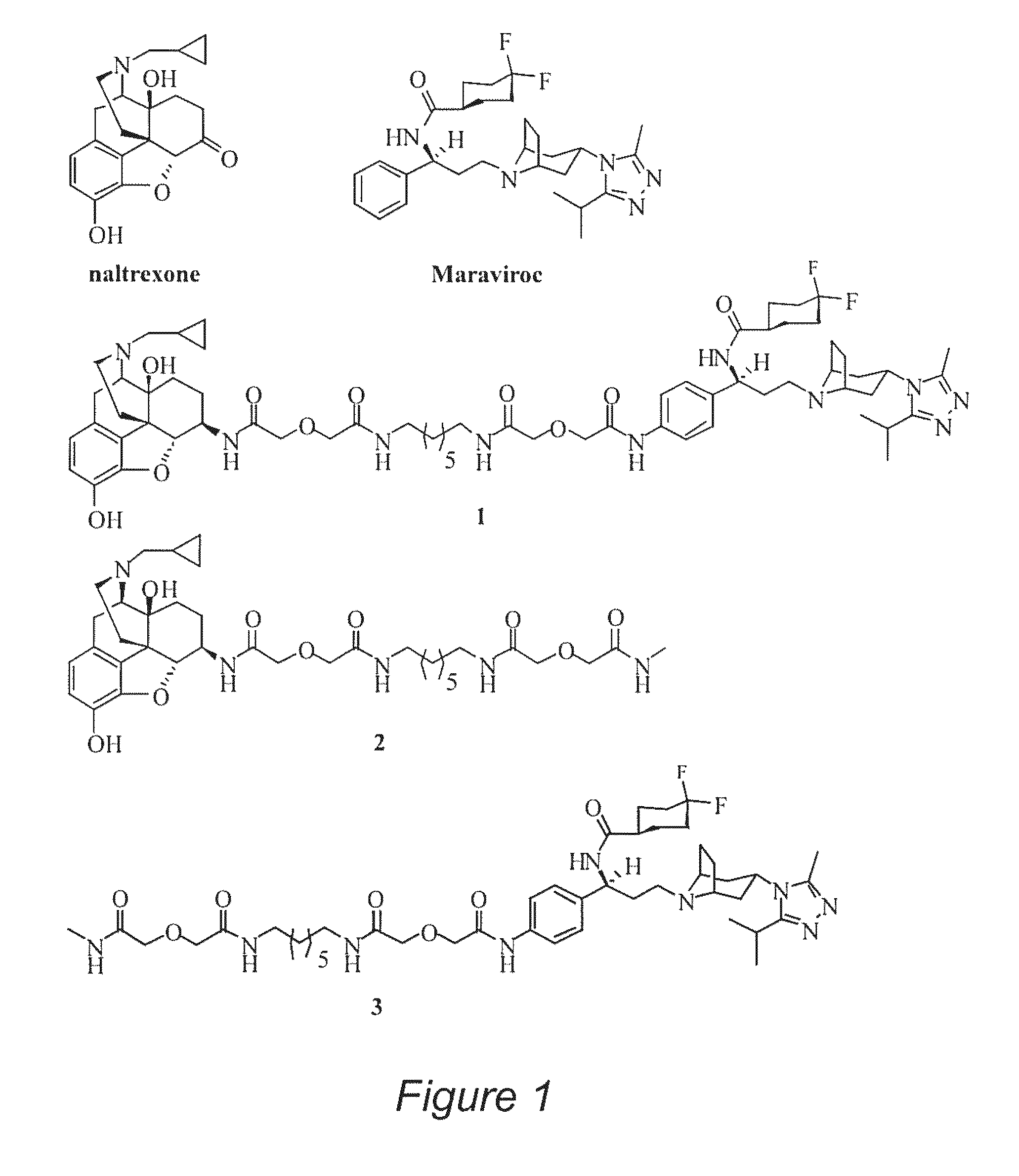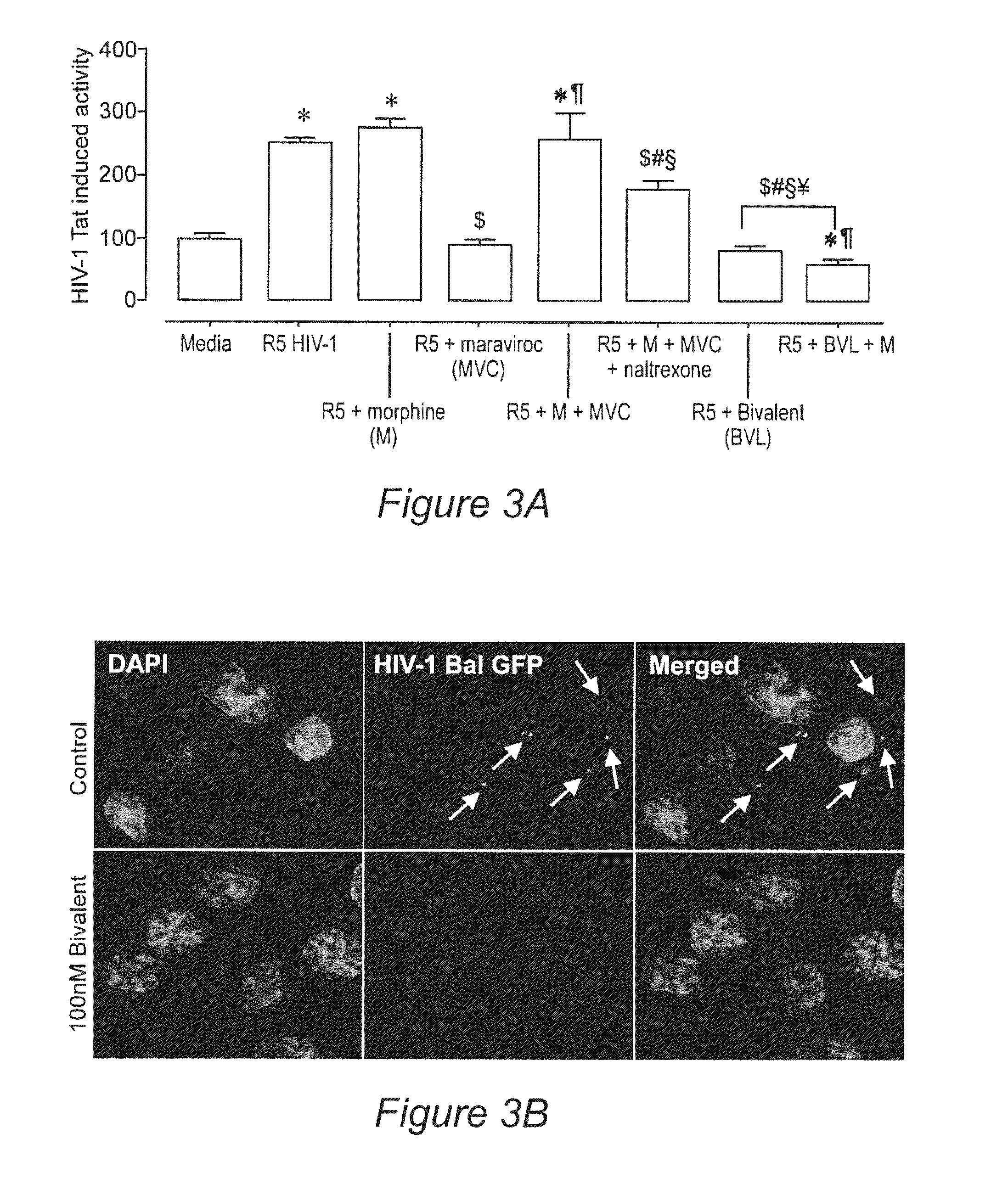Bivalent ligands for the treatment of neurological disorders
a neurodegenerative disease and bivalent ligand technology, applied in the field of bivalent ligands, can solve the problem that it is not enough to target only ccr5, and achieve the effect of avoiding drug-drug interactions and attenuating or eliminating
- Summary
- Abstract
- Description
- Claims
- Application Information
AI Technical Summary
Benefits of technology
Problems solved by technology
Method used
Image
Examples
example 1
Design and Synthesis of an Exemplary Bivalent Ligand
[0093]
A bivalent ligand 1 was designed and synthesized as the first molecular probe to study the biological and pharmacological mechanisms of the putative mu opioid receptor and chemokine receptor CCR5 heterodimers.
Abstract
[0094]The bivalent ligand approach has been utilized not only to study the underlying mechanism of G protein-coupled receptors dimerization and / or oligomerization, but also aimed to enhance ligand affinity and / or selectivity for potential treatment of a variety of diseases by targeting on this process. Substance abuse and addiction have made both the prevention and the treatment of human immunodeficiency virus (HIV) infection more difficult to tackle. It has been extensively studied that morphine, a mu opioid receptor (MOR) agonist, can accelerate HIV infection through up-regulating the expression of the chemokine receptor CCR5, a well-known co-receptor for HIV invasion to the host cells. Meanwhile, two research ...
example 2
Significant Drug Interactions Between Maraviroc and Morphine in Astrocytes: Implications for a New Therapeutic Against neuroAIDS in Drug Abusing Populations
Abstract
[0146]Opiates have been previously reported to enhance the ability of CCR5 (R5)-tropic HIV-1 strains to infect macrophages through the upregulation of CCR5 receptor expression. Moreover, the μ-opioid receptor (MOR) and CCR5 have been shown to undergo bidirectional heterologous sensitization. To explore whether opiates affect the actions of CCR5 HIV-1 entry inhibitors, the effects of morphine on the CCR5 antagonist maraviroc, as well as a bivalent derivative of maraviroc linked to naltrexone (described in Example 1), on HIV-1 entry was evaluatedin primary human astrocytes. HIV-1 entry was monitored in astrocytes transiently transfected with a LTR construct containing a luciferase reporter gene under control of a promoter for the HIV-1 transactivator protein Tat. The effect of maraviroc and the bivalent ligand±morphine on C...
example 3
REFERENCES FOR EXAMPLE 3
[0182]1. Thompson, C. M.; Wojno, H.; Greiner, E.; May, E. L.; Rice, K. C.; Selley, D. E. Activation of G-proteins by morphine and codeine congeners: insights to the relevance of O- and N-demethylated metabolites at μ- and δ-opioid receptors. J. Pharmacol. Exp. Ther. 2004, 308, 547-554.[0183]2. Conklin, B. R.; Farfel, Z.; Lustig, K. D.; Julius, D.; Bourne, H. R. Substitution of three amino acids switches receptor specificity of Gq to that of Gi alpha. Nature 1993, 363, 274-276.[0184]3. Sakamoto, T.; Ushijima, H.; Okitsu, S.; Suzuki, E.; Sakai, K.; Morikawa, S.; Muller, W. E. Establishment of an HIV cell-cell fusion assay by using two genetically modified HeLa cell lines and a reporter gene. J. Virol. Methods 2003, 114, 159-166.
Example 4
A Bivalent Ligand Targeting the Putative Mu Opioid Receptor and Chemokine Receptor CCR5 Heterodimers: Binding Affinity Versus Functional Activities
[0185]A bivalent ligand 1 (FIG. 14) that combines the pharmacophores of naltrexon...
PUM
| Property | Measurement | Unit |
|---|---|---|
| temperature | aaaaa | aaaaa |
| temperature | aaaaa | aaaaa |
| volume | aaaaa | aaaaa |
Abstract
Description
Claims
Application Information
 Login to View More
Login to View More - R&D
- Intellectual Property
- Life Sciences
- Materials
- Tech Scout
- Unparalleled Data Quality
- Higher Quality Content
- 60% Fewer Hallucinations
Browse by: Latest US Patents, China's latest patents, Technical Efficacy Thesaurus, Application Domain, Technology Topic, Popular Technical Reports.
© 2025 PatSnap. All rights reserved.Legal|Privacy policy|Modern Slavery Act Transparency Statement|Sitemap|About US| Contact US: help@patsnap.com



